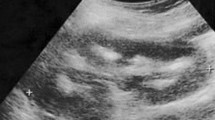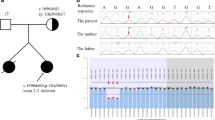Abstract
Bartter syndrome (BS) is a rare renal tubular disorder presenting with hypokalemic metabolic alkalosis, which is classified into five types. KCNJ1 mutations usually cause the neonatal form of BS, type II BS (OMIM 241200). However, this report concerns a female patient with a novel, compound heterozygous KCNJ1 mutation that causes late-onset BS. The unique clinical findings of this case include persistently elevated 1,25(OH)2 vitamin D levels, possibly due to increase prostaglandin E2 levels, and medullary nephrocalcinosis. Treatment with COX-2 inhibitors resolved her hypercalciuria and improved her height and weight; renal function remains stable and there is no progression of nephrocalcinosis.

Similar content being viewed by others
References
Bartter FC, Pronove P, Gill JR Jr, Maccardle RC. Hyperplasia of the juxtaglomerular complex with hyperaldosteronism and hypokalemic alkalosis. A new syndrome. Am J Med. 1962;33:811–28.
Herbert SC. Bartter syndrome. Curr Opin Nephrol Hypertens;203(12):527–532.
Finer G, Shalev H, Birk OS, Galron D, Jeck N, Sinai-Treiman L, Landau D. Transient neonatal hyperkalemia in the antenatal (ROMK defective) Bartter syndrome. J Pediatric. 2003;142(3):318–23.
Brochard K, Boyer O, Blanchard A, Loirat C, Niaudet P, Macher M, Deschenes G, Bensman A, Decramer S, Cochat P, Morin D, Broux F, Caillez M, Guyot C, Novo R, Jeunemaître X, Vargas-Poussou R. Phenotype–genotype correlation in antenatal and neonatal variants of Bartter syndrome. Nephrol Dial Transplant. 2009;24(5):1455–64.
Jeck N, Derst C, Wischmeyer E, Ott H, Weber S, Rudin C, Seyberth HW, Daut J, Karschin A, Konrad M. Functional heterogeneity of ROMK mutations linked to hyperprostaglandin E syndrome. Kidney Int. 2001;59(5):1803–11.
Nozu K, Jun Fu X, Kaito H, Kanda K, Yokoyama N, Krol RP, Nakajima T, Kajiyama M, Iijima K, Matsuo M. A novel mutation in KCNJ1 in a Bartter syndrome case diagnosed as pseudohypoaldosteronism. Pediatr Nephrol. 2007;22:1219–23.
Shuck ME, Bock JH, Benjamin CW, Tsai TD, Lee KS, Slightom JL, Bienkowski MJ. Cloning and characterization of multiple forms of the human kidney ROMK potassium channel. J Biol Chem. 1994;269(39):24261–70.
Schwalbe RA, Bianchi L, Accili EA, Brown AM. Functional consequences of ROMK mutants linked to antenatal Bartter’s syndrome and implications for treatment. Hum Mol Genet. 1998;7(6):975–80.
Peters M, Ermert S, Jeck N, Derst C, Pechmann U, Weber S, Schlingmann KP, Seyberth HW, Waldegger S, Konrad M. Classification and rescue of ROMK mutations underlying hyperprostaglandin E syndrome/antenatal Bartter syndrome. Kidney Int. 2003;64(3):923–32.
Hebert SC, Desir G, Giebisch G, Wang W. Molecular diversity and regulation of potassium channels. Physiol Rev. 2005;85:319–71.
Welling PA, Ho K. A comprehensive guide to the ROMK potassium channel: form and function in health and disease. Am J Physiol Renal Physiol. 2009;297:F849–63.
Carsten A, Pressler CA, Heinzinger J, Jeck N, Waldegger P, Pechmann U, et al. Late-onset manifestation of antenatal Bartter syndrome as a result of residual function of the mutated renal Na+–K+–2Cl− Co-transporter. J Am Soc Nephrol. 2006;17:2136–42.
Yamada M, Matsumoto T, Takahashi N, Suda T, Ogata E. Stimulatory effect of prostaglandin E2 on 1 alpha, 25-dihydroxyvitamin D3 synthesis in rats. Biochem J. 1983;216(1):237–40.
Restrepo de Rovetto C, Welch TR, Hug G, Clark KE, Bergstrom W. Hypercalciuria with Bartter syndrome: evidence for an abnormality of vitamin D metabolism. J Pediatr. 1989;115:397–440.
Kremke B, Bergwitz C, Ahrens W, Schütt S, Schumacher M, Wagner V, Holterhus PM, Jüppner H, Hiort O. Hypophosphatemic rickets with hypercalciuria due to mutation in SLC34A3/NaPi-IIc can be masked by vitamin D deficiency and can be associated with renal calcifications. Exp Clin Endocrinol Diabetes. 2009;117:49–56.
Leonhardt A, Timmermanns G, Roth B, Seyberth HW. Calcium homeostasis and hypercalciuria in hyperprostaglandin E syndrome. J Pediatr. 1992;120:546–54.
Shoemaker L, Welch TR, Bergstorm W, Abrams SA, Yergey AL, Vieira N. Calcium kinetics in the hyperprostaglandin E syndrome. Pediatr Res. 1993;33:92–6.
Moore ES, Langman CB, Favus MJ, Schneider AB, Coe FL. Secondary hyperparathyroidism in children with symptomatic idiopathic hypercalciuria. J Pediatr. 1983;103:932–5.
Author information
Authors and Affiliations
Corresponding author
Additional information
M. A. Linshaw deceased on 12/31/2010.
About this article
Cite this article
Sharma, A., Linshaw, M.A. A novel compound heterozygous ROMK mutation presenting as late onset Bartter syndrome associated with nephrocalcinosis and elevated 1,25(OH)2 vitamin D levels. Clin Exp Nephrol 15, 572–576 (2011). https://doi.org/10.1007/s10157-011-0431-3
Received:
Accepted:
Published:
Issue Date:
DOI: https://doi.org/10.1007/s10157-011-0431-3




